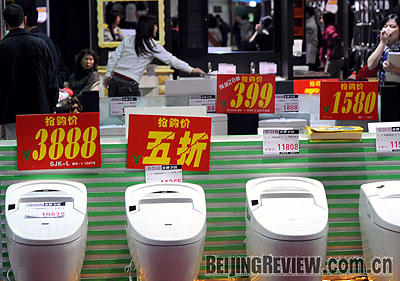|
|

ON SALE: When economic growth slows and circulated money shrinks, prices fall, and consumers buy more. A stallkeeper waits for customers at a market in Yinchuan, Ningxia Hui Autonomous Region (LIU QUANLONG) |
The central bank officials who racked their brains months ago about how to curb inflation are now exerting themselves to overcome deflation. The monetary policy report for the third quarter released on November 17 by the People's Bank of China (PBC), the country's central bank, indicates that the current monetary policy aims to prevent deflation in the near term.
Ten days later, the PBC cut the benchmark one-year deposit and loan interest rates by a massive 1.08 percentage points. The central bank also said that as of December 5, it would lower the reserve requirement ratio by 1 percentage point for big banks and by 2 percentage points for small and medium-sized lenders.
The government's switch from curbing inflation to preventing deflation appears abrupt. The central bank's monetary policy report for the first half said curbing inflation was the major task. Many economists who had analyzed the situation during the first half were then wondering if the government could accomplish its goal of curbing inflation by the end of this year.
He Liping, a professor of finance at Beijing Normal University, told Beijing Review that because of the global financial turmoil, China's economy faced the risk of a downturn, which would ease the pressure of inflation but strengthen that of deflation.
At a November 14 press conference held by the Information Office of the State Council, Yi Gang, Vice Governor of the PBC, said that threats of inflation had been eliminated by and large.
Less circulated money
The PBC report shows that the current amount of money in circulation has started to shrink. Financial statistics released by the PBC indicate that in October broad money (M2) grew 15.02 percent year on year, a decline of 0.28 percentage point from the previous month. This was the fifth month that saw a slowdown in M2 growth, a bottoming out of growth during the last 40 months.
During this period, growth of narrow money (M1) stood at 8.85 percent, or 0.55 of a percentage point lower than that in September. The growth of M1 had declined for six consecutive months and is now at the same level of 1997 when Asia was in the throes of financial turmoil.
|
 SEEKING CUSTOMERS: Some domestic sectors such as the decoration materials industry have seen their sales fall because of lagging consumer demand. Businesses at a recent home decor fair in Fujian Province offer various price discounts for their products, but attract few buyers (JIANG KEHONG)
SEEKING CUSTOMERS: Some domestic sectors such as the decoration materials industry have seen their sales fall because of lagging consumer demand. Businesses at a recent home decor fair in Fujian Province offer various price discounts for their products, but attract few buyers (JIANG KEHONG) |
He said a slowdown of growth in the money supply, especially demand deposits represented by M1, means enterprises have become less active. Moreover, differences between the growth rates of M1 and M2 continue to expand, indicating that more deposits are being converted to time deposits, while capital active on the market is shrinking, pointing to the possibility of deflation. When the amount of circulated money shrinks, time deposits among financial institutions increase.
The report shows that at the end of September, the outstanding renminbi and foreign currency deposits among all financial institutions stood at 46.7 trillion yuan ($6.84 trillion), a year-on-year increase of 18.2 percent, which was 2.2 percentage points higher than the rate during the same period last year. The balance was 6.6 trillion yuan ($966.33 billion) higher than that at the beginning of this year, or 1.9 trillion yuan ($278.18 billion) more than the increased volume during the same period last year.
According to the PBC report, in terms of the sources of and time frames for renminbi deposits, individual deposits maintained fast growth, while non-financial corporate deposits slowed, and fiscal deposits showed a steady increase. Time deposits from individuals and companies have increased quicker than a year ago. At the end of September, the outstanding renminbi deposits from individuals was 20.8 trillion yuan ($3.05 trillion), up 21.1 percent from a year ago, which was 14.1 percentage points higher than the rate in the same period last year. The balance was 3.3 trillion yuan ($483.16 billion) higher than that at the beginning of this year, and most of the increased volume was from time deposits. At the same time, non-financial corporate renminbi deposits totaled 21 trillion yuan ($3.07 trillion), up 15.1 percent year on year, 9.9 percentage points lower than that in the same period last year. The balance was 2.2 trillion yuan ($322.11 billion) higher than that at the beginning of this year, about 593 billion yuan ($78.92 billion) of which came from time deposits.
| 